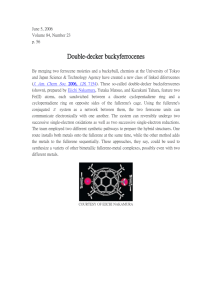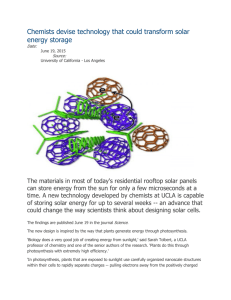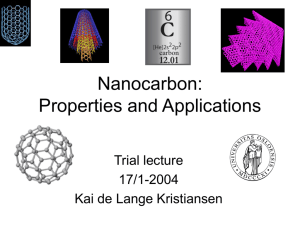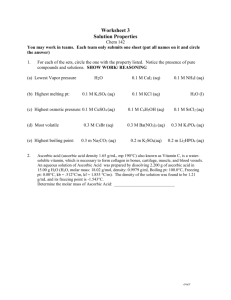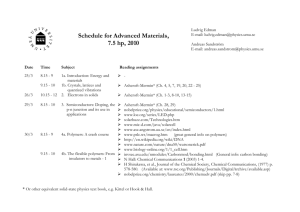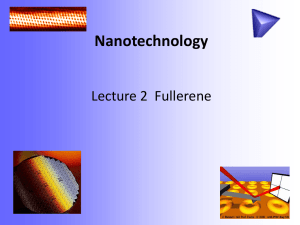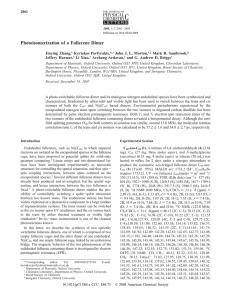File - Rigoberto Burgos E
advertisement
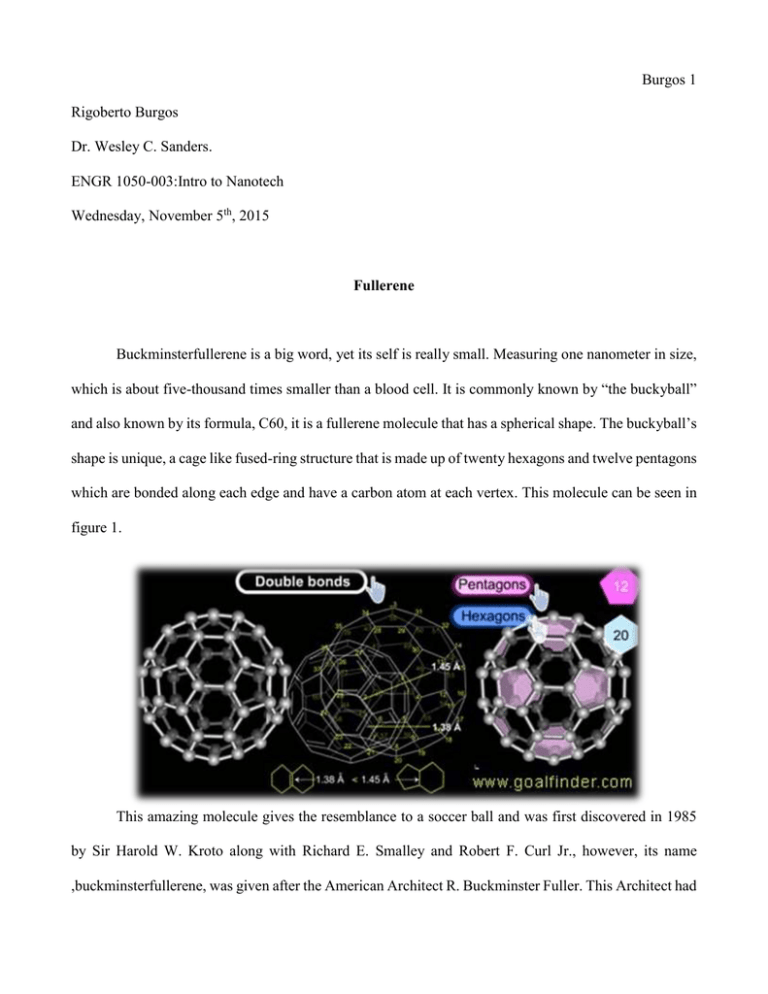
Burgos 1 Rigoberto Burgos Dr. Wesley C. Sanders. ENGR 1050-003:Intro to Nanotech Wednesday, November 5th, 2015 Fullerene Buckminsterfullerene is a big word, yet its self is really small. Measuring one nanometer in size, which is about five-thousand times smaller than a blood cell. It is commonly known by “the buckyball” and also known by its formula, C60, it is a fullerene molecule that has a spherical shape. The buckyball’s shape is unique, a cage like fused-ring structure that is made up of twenty hexagons and twelve pentagons which are bonded along each edge and have a carbon atom at each vertex. This molecule can be seen in figure 1. This amazing molecule gives the resemblance to a soccer ball and was first discovered in 1985 by Sir Harold W. Kroto along with Richard E. Smalley and Robert F. Curl Jr., however, its name ,buckminsterfullerene, was given after the American Architect R. Buckminster Fuller. This Architect had Burgos 2 constructed a geodesic dome under the same structural principles, and therefore influenced Kroto, Smalley , and Curl’s structure conjecture. This amazing discovery led to not only a new understanding of the behavior of sheet materials, but also it opened an whole new era for nano-science and nanotech alike. “Kroto, analyzed the spectra of carbon chains… These measurements later led to the detection, by radioastronomy, of chainlike molecules consisting of 5 to 11 carbon atoms in interstellar gas clouds and in the atmospheres of carbon-rich red giant stars”. (Kroto) Kroto then learned about a laser apparatus that could vaporize any material into a soot that could then be studied. It was then that they decided to try it on graphite, They proved that carbon chains were produced but to their surprise the experiment also showed unknown carbon atoms containing 60 atoms also formed. This however was not the only way to create C60 atoms. Later on other methods where found including, the electric arc discharge method and the chemical vapor deposition. The discovery of buckyballs has helped better understand graphite, and on a small scale. It is also known that a closed buckyball or nano tube are the “most stable form of a carbon aggregate, containing tens to several hundred thousands of atoms” (Kroto). Which potentially makes closed fullerene structures usable for tons of future applications. Buckyballs can be used for more than just technology advances, they can also be use for medical Burgos 3 improvement like nano medicine, cosmetics, and electronics, however, for this assessment, medicine and technology will be more specifically looked into. Fullerene materials are increasing do to their unique properties such as, “high electrons affinity and electron transfer capability as well as antioxidant and radical scavenging activities.” ( Srdjenovic) Fullerene is insoluble but by adding certain things, it can enhance its solubility. Due to the buckyball’s spherical shape the carbon atoms are highly pyramidalized, which means they have a lot of peripheral atoms, and because of this, it increases it chanced of reactivity to certain atoms and molecules. In a recent study, it was investigated to see the effect of a single oral administration of a single oral administration of C60 and SWCNT. This test was done on rats, and the test was to try and repair DNA. That outcome actually result in no significant increase in repair activity, its showed oral exposure to low doses of C60 and SWCNT is associated with elevated levels of 8-oxodG in the liver and lung. In other words at this time minimal repair was made but as in all other experiments it just leaves room for improvement. One of the chemical configurations that resulted in an amazing outcome was a fullerenol which is an antioxidant that has a formula of C60 (OH)24. A recent 2014 study showed that c60 fullerene with coexposure to organic industrial chemicals actually nay strengthen the health effects of the chemicals. It advised that since the interaction time, between the chemicals and C60 , was short, “The co-effects where in fact minor. It also showed that organic molecules readily coaggregate with C60 fullerene in an aqueous environment. C60 clusters may contain more hydrophobic than hydrophilic organic molecules. Co-aggregation might explain the increased cytotoxicity of hydrophobic compounds in unfiltered fullerene suspensions but not the increased immunotoxicity of hydrophobic compounds in unfiltered suspensions. The results reported here stress the importance of being aware of different co-exposure scenarios at workplaces as co-exposure to fullerene together with other chemicals may Burgos 4 pose effects on health. Our results can be applied also to environmental exposure to fullerene” ( Srdjenovic) In other words, it has helped make chemicals effect safer, although it was a short study it may prove to be factual for other/ future applications. Another great concept where fullerene can and will be used is in the electronics department. Recent studies have being trying to use fullerene in the making of high-performance polymer solar cells. In this study another variation of fullerene was used, a poly(ethylene glycol) end caped fullerene derivative. It formula was PEGN-C60. In this study the fullerene is being used as an electron buffer layer in polymer solar cells versus other blends. In this test the fullerene surpassed the results than those of a normal EBL (electron buffer layer) and even more of a polymer solar cell that did not have any EBL but rather just a Ca/Al lend. Bottom lime is” PEGN-C60 works well for all the three systems we tested, it could also work for other donor:-acceptor system” (Zhang). Not only is fullerene helping in increasing the process cycle efficiency but also “fullerene crystallization in mixtures of the two most commonly used fullerene derivatives, PC61BM and PC71BM, Burgos 5 is strongly suppressed at annealing temperatures that are suitable for roll-to-roll printing processes…The use of fullerene mixtures is a visible strategy to retain the photovoltaic performance polymer solar cells blends, which would otherwise rapidly deteriorate at elevated temperatures” ( Lindqvist ). In conclusion Fullerene mixtures is something that seems to have high expectation in many things wether it is to improve the technology we have like reducing the cost of the acceptor material yet still improving, or helping cure diseases that we are still learning to understand. None the less Fullerene are still fairly new and we are still figuring out and discovering new potential for this little yet giant discovery. Burgos 6 Works Cited Page Folkmann, Janne K., et al. "Oxidatively Damaged DNA in Rats Exposed by Oral Gavage to C₆₀ Fullerenes and Single-Walled Carbon Nanotubes." Environmental Health Perspectives 2009: 703. JSTOR Journals. Web. 6 Nov. 2015. Fullerene Advanced-Bucky Ball-Nanotube (animated Chemistry). Digital image. Goalfinder.com. N.p., n.d. Web. Kapadia, Gargi. Carbon Nanotubes: Properties, Synthesis, & Application in Electronic Devices. Digital image. Slideshare. N.p., n.d. Web. Kroto, Sir Harold W…, and David R.M Walton. “Fullerene.” Encyclopædia Britannica (2014): Research Starters. Web. 6 Nov. 2015 Lehto, Maili , et al. “Co- Exposure With Fullerene May Strength Health Effects Of Organic Industrial Chemicals.” Plos ONE 9.12 (2014): 1-24. Academic Search Premier. Web. 6 Nov. 2 Lindqvist, Camilla, et al. "Fullerene Mixtures Enhance The Thermal Stability Of A NonCrystalline Polymer Solar Cell Blend." Applied Physics Letters 104.15 (2014): 1533011-153301-4. Academic Search Premier. Web. 6 Nov. 2015. Srdjenovic, Branislava, et al. "Antioxidant Properties Of Fullerenol C60(OH)24 In Rat Kidneys, Testes, And Lungs Treated With Doxorubicin." Toxicology Mechanisms & Methods 20.6 (2010): 298-305. Academic Search Premier. Web. 6 Nov. 2015. Zhang, Zhi-Guo, et al. "Poly(Ethylene Glycol) Modified [60]Fullerene As Electron Buffer Layer For High-Performance Polymer Solar Cells." Applied Physics Letters 102.14 (2013): 143902. Academic Search Premier. Web. 6 Nov. 2015. Burgos 7
